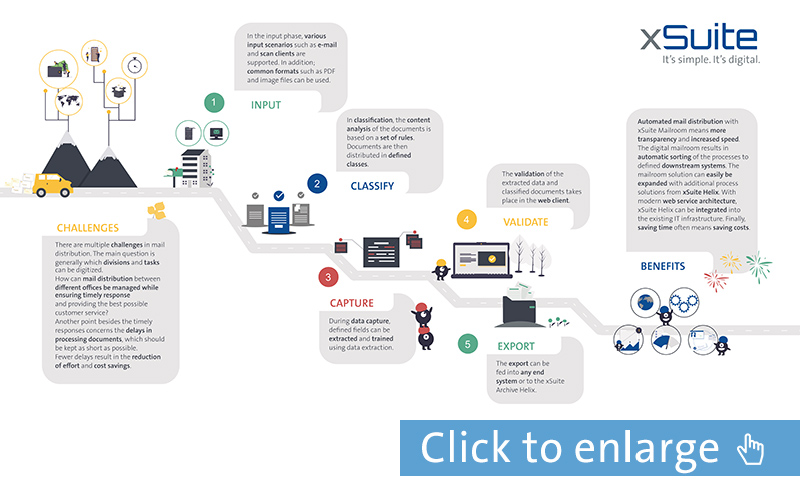xSuite Blog
Expert Knowledge on Digitalization & Automation of Business Processes

xSuite Blog
Expert Knowledge on Digitalization & Automation of Business Processes
A Digital Mailroom in the Cloud: Fully Automated Processing of All Your Company’s Incoming Mail
Topic: Digitalization | Cloud | Incoming Mail

Whether it comes in digital form as e-mail or in traditional letter-post form, incoming mail is crucial for every organization. For most companies, managing a mixture of digital and paper-based mail presents a major challenge, particularly given the many different types of documents received, from invoices and customer correspondence to job applications. In many companies, letter post is still organized and processed in paper form.
Distributing mail manually can seem rather old-fashioned, especially in companies that have fully digitized many of their other divisions. Yet mailrooms tend to be much the same as they were 50 years ago, with staff manually sorting mail into pigeonholes and then either distributing it to colleagues over the course of the day or waiting for colleagues to pick up their mail themselves.
Digitization: both a challenge and an opportunity
For global enterprises, the task of organizing incoming mail for a steadily growing number of national and international locations is becoming increasingly challenging. This is where digitization can help. A term often associated with digitization is “digital transformation.” But what does this mean for mail distribution? One important question companies need to answer is which specific tasks and areas can be digitized. This question is particularly tricky for companies that have offices scattered all over the world. How can such companies distribute their mail across their various locations? How can top customer service and fast response times be guaranteed? How can companies reduce wait times for documents and thereby ensure that they secure early payment discounts, especially when the responsible person is on vacation or otherwise unavailable? Finally, companies need to save time and money in the long term.
The automated mailroom: the gateway to a paperless office
Automated mailrooms offer a solution to the challenges outlined above and can serve as a gateway to a paperless office. A digital cloud-based mailroom can decentrally and automatically process all of an organization’s incoming mail, using an intelligent classification based on the organization’s own policies to sort mail into defined document categories. Different mail items, regardless of whether they are invoices, job applications, requests for payment, delivery notes, customer correspondence, or circulars, are immediately sorted into the correct category and routed to the appropriate receiving system or contact person.
The digital mailroom in the cloud: a process-based approach
The digital mailroom begins with incoming mail. Documents arrive in both digital and traditional letter-post form and enter the digital mail distribution system in a number of ways. For example, they can be sent as full-text PDFs to defined inboxes via e-mail and transferred to the cloud system via an interface. Meanwhile documents sent by letter post are scanned using a scan client and then transferred to the cloud system. In step 2 of the process, an intelligent classification system analyzes the content of the incoming documents and then sorts these into predefined categories. In step 3, fields from the documents are extracted, captured, and trained by means of data extraction. Validation of the extracted data and classified documents is then performed in the web client. Finally, the documents are exported via a defined interface to an end system or archive.
An automated mailroom in the cloud: what are the benefits?
An automated mailroom solution offers a host of opportunities and benefits. Firstly, it allows all of an organization’s incoming mail — both letter-post and digital mail — to be processed and distributed decentrally. This makes the entire mail distribution process faster and more transparent, which in turn enables organizations to reduce wait times and respond to queries more quickly. Mail is automatically sorted to receiving systems.
Secondly, modern web-service architecture can be used to integrate a cloud-based mailroom solution into existing IT infrastructures. This is where the benefits of a cloud solution become really apparent. As well as involving low implementation and configuration costs, “hybrid” scenarios combine the best of both worlds. Core processes, such as industry-specific processes and specific applications of central ERP systems, continue to run locally. Meanwhile, additional processes — in other words, processes that are highly standardized — can be migrated to the cloud.
This results in significantly lower configuration and infrastructure costs, as the software no longer has to be managed locally.
Another advantage is that the services can be accessed from anywhere using any connected end device. In addition, use is calculated based on the volume of documents per month, which means that customers only pay for what they actually need. When demand rises, the volume can be increased, ensuring both scalability and convenience. Finally, another benefit is that automatic updates are performed by the provider of the cloud solution. New versions are automatically provided at regular intervals, so customers can be sure they are always working with an up-to-date solution.
Topic
- AP Automation (28)
- Digitalization (28)
- SAP (18)
- Cloud (15)
- S/4HANA (10)
- E-Invoicing (9)
- Skills Shortage (6)
- Supplier Portal (6)
- AI and Machine Learning (5)
- Procurement (5)
- Invoice (5)
- GDPR (4)
- Software Development and Implementation (4)
- xSuite Group (4)
- Archiving (3)
- Usability and User Experience (3)
- RPA (2)
- Dynamic Discounting (1)
- Blockchain (1)
- Incoming Mail (1)



